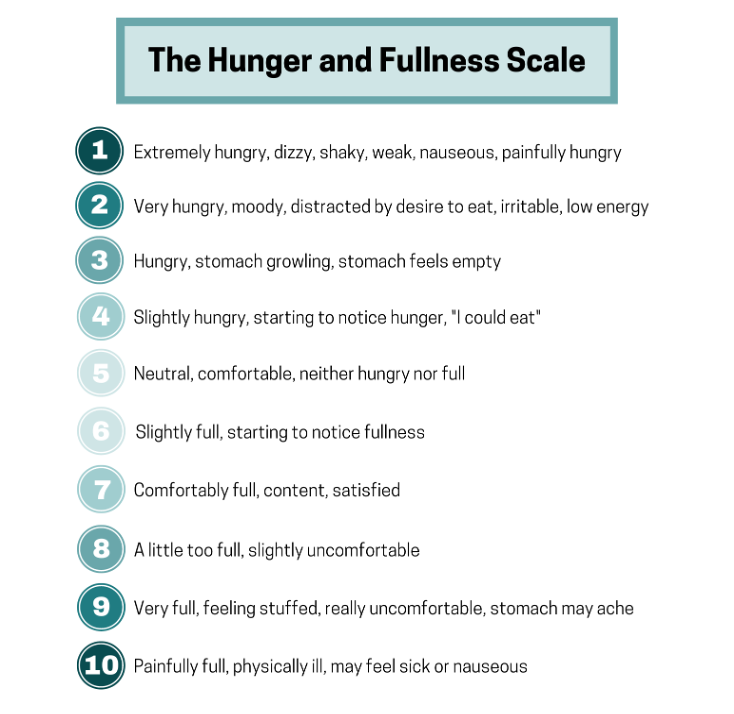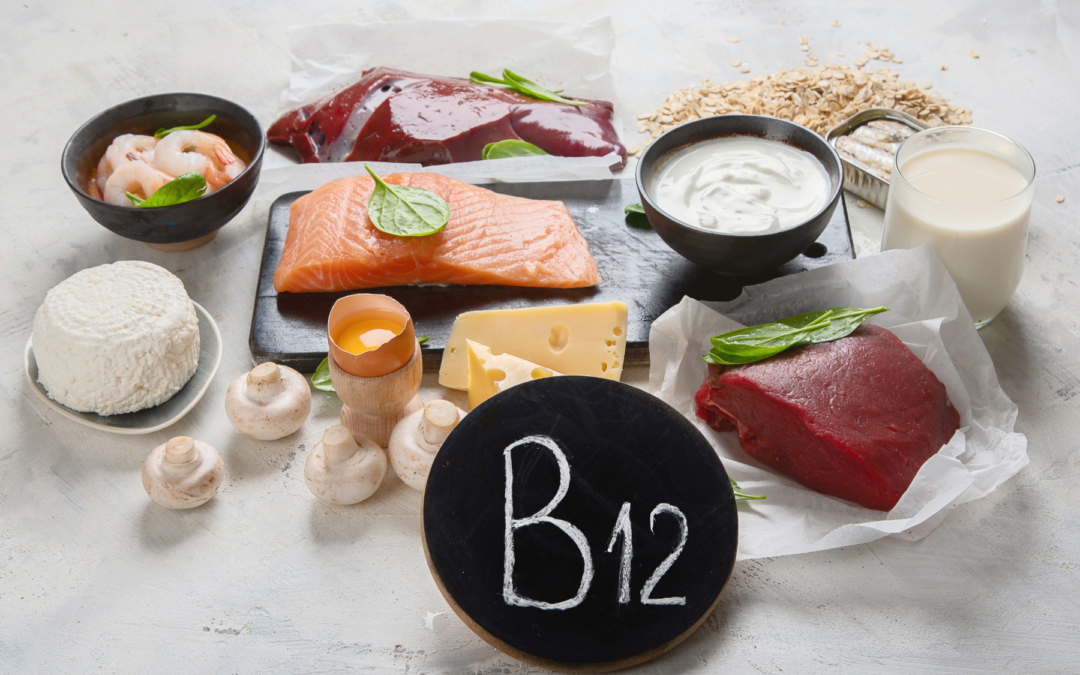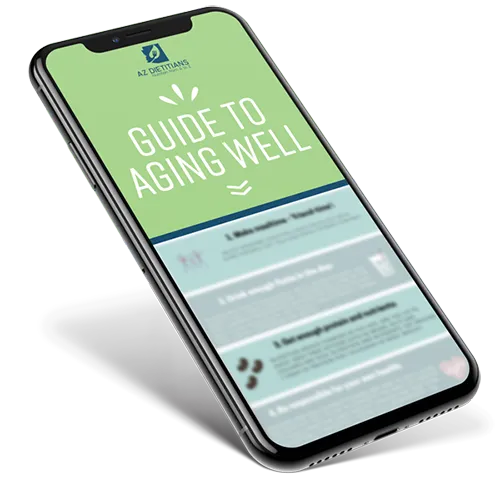The human body is truly incredible. We have hundreds of mechanisms in our bodies that send us signals to tell us what we need physically and emotionally. The hunger and fullness scale is one way we can regulate how much we eat and when.
The body tells us when we are tired and need sleep. You might feel a churning in your stomach when you’re nervous about giving a presentation. You’re likely to make your way to the bathroom when you feel the urge to pee. We feel pain when we touch a hot stove. Your mouth may feel dry when you need a glass of water.
These signals provide useful feedback that we can use to help us care for our bodies so we feel our best. Our bodies also have feedback systems that tell us when we need energy (hunger) and when we have had enough food (fullness).1
How does this affect our calorie needs?
While calorie estimations can be useful tools to get a general idea of how much food we need per day but they’re not entirely accurate. The truth is that our calorie needs vary from day to day-sometimes by several hundred calories from one day to the next! Our calorie needs change based on our activity level, hormonal changes, how much we have eaten recently, and more. Learning to listen to our hunger and fullness cues can help us know when and how much to eat. This allows us to fuel our body appropriately and give it what it needs each day.
Understanding the Hunger Scale
The hunger and fullness scale is a tool that can be used throughout the day. You can use it before, during, and after meals to gauge how much food you need and when you should eat. A “1” on the hunger and fullness scale means you are extremely hungry. You may feel dizzy or weak or painfully hungry. On the opposite end of the scale is a “10” where you are extremely full. At a “10” you may feel sick or nauseous. These are the extreme ends of the scale.
Similarly to other feedback systems in your body, the signals will become stronger and more difficult to ignore. The longer you wait to eat food, the more distracting and uncomfortable your feelings of hunger will become. The more you eat and ignore your feelings of fullness, the more full and sick you will feel. Your body uses these sensations to guide you to make decisions about your food intake and help you care for your body.
Just as you wouldn’t question the feeling that you need to use the restroom, you can trust in your body’s ability to alert you when you need food and when you have had enough.
How to apply the Hunger Scale:
Most people feel their best when they try to stay between a “3” and “8” on the scale most of the time. If you wait a long time before eating a meal and you get down to a “1” or “2” on the scale. You may enter your next meal feeling very uncomfortable and out of control around food. You may want to eat anything and everything in sight. In this state, it becomes challenging to slow down and listen to your fullness cues which often leads to eating past a level of comfortable fullness. This is a natural reaction to not eating for a long period of time!
If you swim underwater and don’t breathe for a long time, you will come up gasping for air and need to take some fast, deep breaths to return your breathing to normal and feel comfortable again. Our body does this with food too. We can avoid these unpleasant feelings on the extreme ends of the spectrum if we aim to start eating at a “3” or “4” and stop eating when we are at a “7” or “8”. This can help you feel energized throughout the day, enter mealtimes feeling in control, and can help you avoid unpleasant feelings of extreme hunger and fullness.
Continue to be intuitive
The Hunger and Fullness Scale is not meant to be a rigid rule that tells you exactly when or how much to eat. It is a tool that can be used as a guide but should be used with flexibility and practicality, not judgment or rigidity.
If you are at a “4” on the scale and you’re about to go for a run then you probably don’t want to eat until you are at a “7” or “8”. Eating a big meal before a run can cause stomach cramps or make you feel sluggish. You may experience so much discomfort that you are unable to finish your planned workout. In this case, you might choose to have a light snack before your workout. This will give you enough energy to have a successful run without weighing you down with a heavy meal. Then after you complete your workout, you could eat a larger meal with enough food to feel comfortably full and satisfied.
Sometimes it is perfectly appropriate to eat past fullness. If you just ate a birthday meal and now it’s time for cake, you don’t need to turn down the cake just because you aren’t feeling physically hungry anymore. If the cake sounds good to you and is something you would like to experience, then you can eat the cake without concern or judgment.
Other times it may be practical to eat before you get to a “3” or “4” on the hunger scale. If you aren’t feeling quite ready to eat something but you have back-to-back meetings scheduled and know you won’t be able to eat for many hours then it might be a good idea to eat something now. This helps prevent you from feeling ravenous when you finally do get a chance to eat.
Ease into it!
Be patient with yourself and start slowly as you practice using this tool. If you have spent a lot of time ignoring your hunger and fullness cues then it may feel challenging at first. Consider starting with just one meal each day. Check-in with yourself before you begin eating, during the meal, and after completing your meal. Take note of how you’re feeling and where you are on the scale.
Practice paying attention to the sensations that you feel at various levels of hunger. Everyone experiences slightly different sensations at different points on the scale. Some people may feel irritable or angry as their hunger increases. Others may feel weak or nauseous. With practice, you will be able to learn how hunger and fullness feel to you.
Try not to get frustrated or be judgemental of yourself. Instead, get curious about the experience and observe how you are feeling physically and emotionally without judgment. Remember, this scale is not a rule of when or how much you have to eat. It’s simply a tool used to gather the information that you can use to guide your eating decisions in the future.
It’s not for everyone or every situation
There are situations where this scale may not be useful or applicable. If you experience food insecurity, have an eating disorder or a history of disordered eating, have a GI disease, are on certain medications, or have other health conditions then your hunger and fullness cues may be dampened or altered, making them less accurate. In these situations, it’s best to work with your healthcare team, including a dietitian, to determine the best way of eating for you.
The Bottom Line
This scale is not a set of rules used to measure how successful you are at feeding yourself. Even as you become attuned to your hunger and fullness cues, you will overeat and undereat sometimes. Some days you may not feel hungry at all and other days you may feel like nothing will satisfy your endless hunger. This is a perfectly normal part of eating and your body can handle all of these experiences. This is simply a tool you can use in whatever way feels right for you to help you gather information to care for your body and help you feel your best.
References:
- Austin J, Marks D. Hormonal regulators of appetite. Int J Pediatr Endocrinol. 2009;2009:141753.







